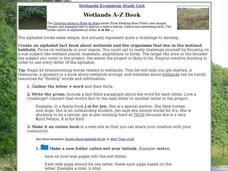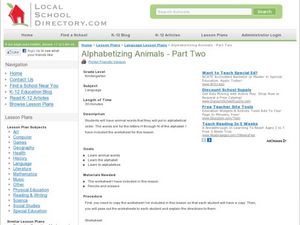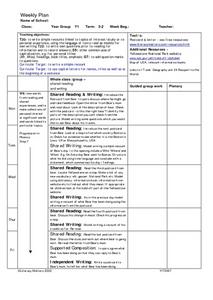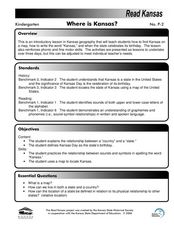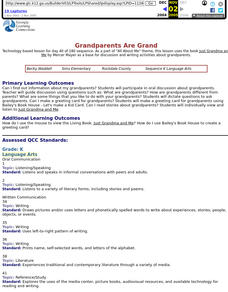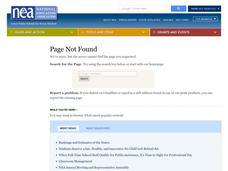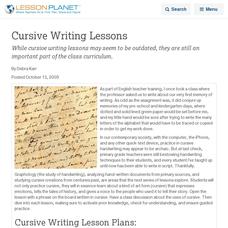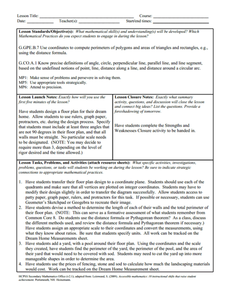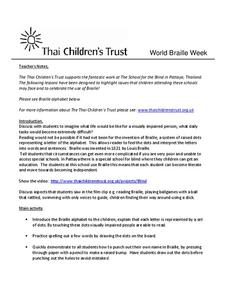Curated OER
Feelings From A to Z
Third graders create a class A to Z Feelings book to explore emotions, discover new words, pose for a "feeling" icture, and write about the feeling.
Curated OER
Dictionary Guide Words: How Do They Guide Us?
Fourth graders, after brainstorming what the word "guide" means, examine how to use guide words in a dictionary to locate words. They define "guide," identify guide words in a variety of dictionaries and locate words using guide words....
Curated OER
Wetlands A - Z Book
In this wetlands worksheet, students follow directions on how to make an online a - z book about the wetlands. Students follow 5 sets of directions.
Curated OER
Alphabetizing Animals- Part Two
Students identify animal names and put them into alphabetical order. In this word study instructional activity, students recite the names of animals and alphabetize the names. Students complete a worksheet as a follow-up activity.
Curated OER
Learning How to Send Messages in Code
Learning about the use of secret codes can help students practice important skills.
Curated OER
Atomic Energy
In this science worksheet, students use basic scientific concepts to complete the series of puzzles while focusing upon atomic energy by exploring alpha, beta, and gamma decay.
Curated OER
"Postcard From Bear"
Young scholars complete various activities related to the book "Postcard From Bear." They participate in a shared reading activity, identify the locations in the book on a map, and write a postcard to the bear in the story.
Curated OER
Agents of Erosion and Deposition
In this science worksheet, students play a game of shoreline charades using picture symbols and other games to cover the concept of erosion or deposition.
Curated OER
Where is Kansas?
Students explore U.S. Geography by analyzing a map. In this state vs. country lesson, students utilize a U.S. map and locate the state of Kansas before researching the history and customs of the state. Students collaborate as a class to...
Curated OER
A World of Symmetry
Students identify lines of symmetry. In this symmetry instructional activity, students create objects and identify their lines of symmetry. They answer questions about lines of symmetry. Students cut shapes out of cookie dough and...
Curated OER
Grandparents Are Grand
Students to interview their grandparents. It uses the book, "Just Grandma and Me." students brainstorm and select the questions they each ask their grandparents.
Curated OER
The Mission of the Prophets
Students examine the purpose and significance of the Manifestations of God. They create a code-breaker chart and uncover a hidden message in a puzzle, read a story and answer discussion questions, and write a reflection and evaluation...
Curated OER
"Tom's Night Out"
In this reading comprehension worksheet, students complete a variety of short activities directly related to the reading of the poem, "Tom's Night Out."
Curated OER
Spanish in English
What do the words alligator, armadillo, and cockroach all have in common? Each one is an English word with Spanish origins. Introduce young etymologists to the joys of discovering word origins with a lesson that asks them to create a...
Curated OER
The Value of a Number
Students assess informal methods to solve real-world problems that utilize simple equations that involve one variable. They incorporate concrete objects to assist them in the solving of a variety of equations. The students are actively...
Curated OER
The Magic of Algebra: Original Lesson Plan
Students participate in a teacher led math "trick." The teacher "reads the mind of the students. The answer to the problem is always 4, and by following the directions, the teacher can guess that students are thinking of Denmark, and...
Curated OER
Cursive Writing Lessons
While cursive writing lessons may seem to be outdated, they are still an important part of the class curriculum.
Curated OER
Make Bark and Leaf Rubbings
Young scholars explore natural resources by creating art from plant materials. In this leaf rubbings lesson, students identify the plants that shed bark and leaves and discuss how it helps them survive in specific environments. Young...
Curated OER
Introduction to the Computer
Students visit the computer lab to learn the parts of the computer and type their names and their lunch numbers.
Curated OER
Perimeter and Area
Students calculate the perimeter and area of given figures and lengths.
Curated OER
Folding Shapes; Are the Sides the Same?
Second graders explore geometry by experimenting with fold-ables. In this geometric shapes lesson, 2nd graders utilize cutout shapes from construction paper which they experiment with by folding. Students examine the symmetry and...
Curated OER
Thai Children's Trust
Pupils spell words in braille and learn how to use braille to punch out their names. In this braille lesson plan, students discuss what life would be like for a visually impaired person.
Curated OER
The Best Pet
Young scholars listen to the story , Pet Show, and discuss the variety of animals that were in the show. The class recalls the animals and practice sounding out the names. Then they decide which animal should receive the best of show...
Curated OER
How Much for Your Name?
Learners create different coin combinations for a single amount, practice counting, demonstrate their knowledge of the value of coins and demonstrate their knowledge of coin combinations.




